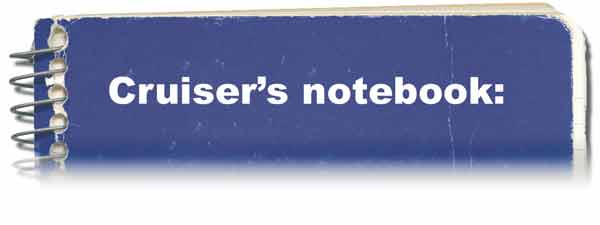

Pulling an All-Nighter
By Cyndi Perkins
Motoring and/or sailing your boat from 1 in the afternoon until 8:30 the next morning might sound like a crazy way to travel, unless you’re a cruiser. But seasonal weekend boaters can benefit from this strategy. My husband Scott and I have been running our 32-foot sailboat Chip Ahoy at night for several years, using longer passages to travel farther afield on precious three-day weekends.
The routine went like this: The captain
admits to superstition about leaving on
Fridays, so we’d normally depart
sometime after midnight. By noon
Saturday Chips was closing in on some of
Lake Superior’s most outstanding
destinations: anchored at Isle Royale
National Park, or just a few hours away
from the Apostle Islands or seven hours
from Ontario, Canada. Because Scott set
a Tuesday-Friday summer schedule at our
electronics shop, we were able to enjoy
our destination Sunday and sail home on
Monday.
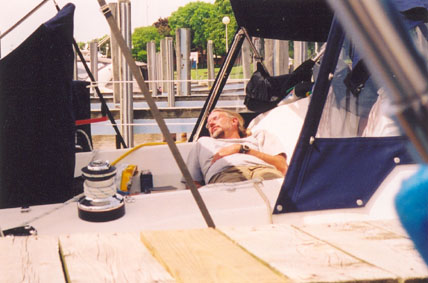 |
| Even with a crew and watch system, overnight passages can create a sleep deficit. Jay Haugen of Faith Afloat snoozes in Port Huron, Michigan, after a marathon trek across Lake Erie, up the Detroit and St. Clair Rivers to the mouth of Lake Huron. |
Traveling the lake on a calm clear night
is a beautiful experience. Night watch
rewards include shooting stars, Northern
Lights and simultaneous sunset/moonrise
vistas. Even when it’s cold and the
waves are black and nasty, the
experience can be exhilarating.
When we began cruising full-time in
August 2003, embarking on America’s
Great Circle Loop, we continued sailing
and/or motoring at night. Often it was
our choice. Traveling down Florida’s
West Coast in December 2003 jumps of 20
hours or more in the Gulf of Mexico were
a means to reach warmer weather. At
other times, particularly in the
heartland river system, we ran out of
daylight and with current against us
were forced to find our next port in the
dark.
Buddy boating certainly came in handy in
those situations. We kept in touch via
marine radio or walkie-talkies. Cruisers
in speedier boats that had passed us
earlier in the day were, bless them,
waiting to help us dock in unfamiliar
territory.
On a 22-hour jaunt across the armpit of
Florida from Pensacola to St. Joseph
Bay, we checked in every couple of hours
with our 35-foot Catalina buddy boat
Faith Afloat, of Sleepy Eye, Minnesota.
In the dark before dawn, the hours when
weary or inexperienced passagemaker need
it most, even the lamest joke can boost
morale: “It’s 2 a.m., do you know where
your boat is?”
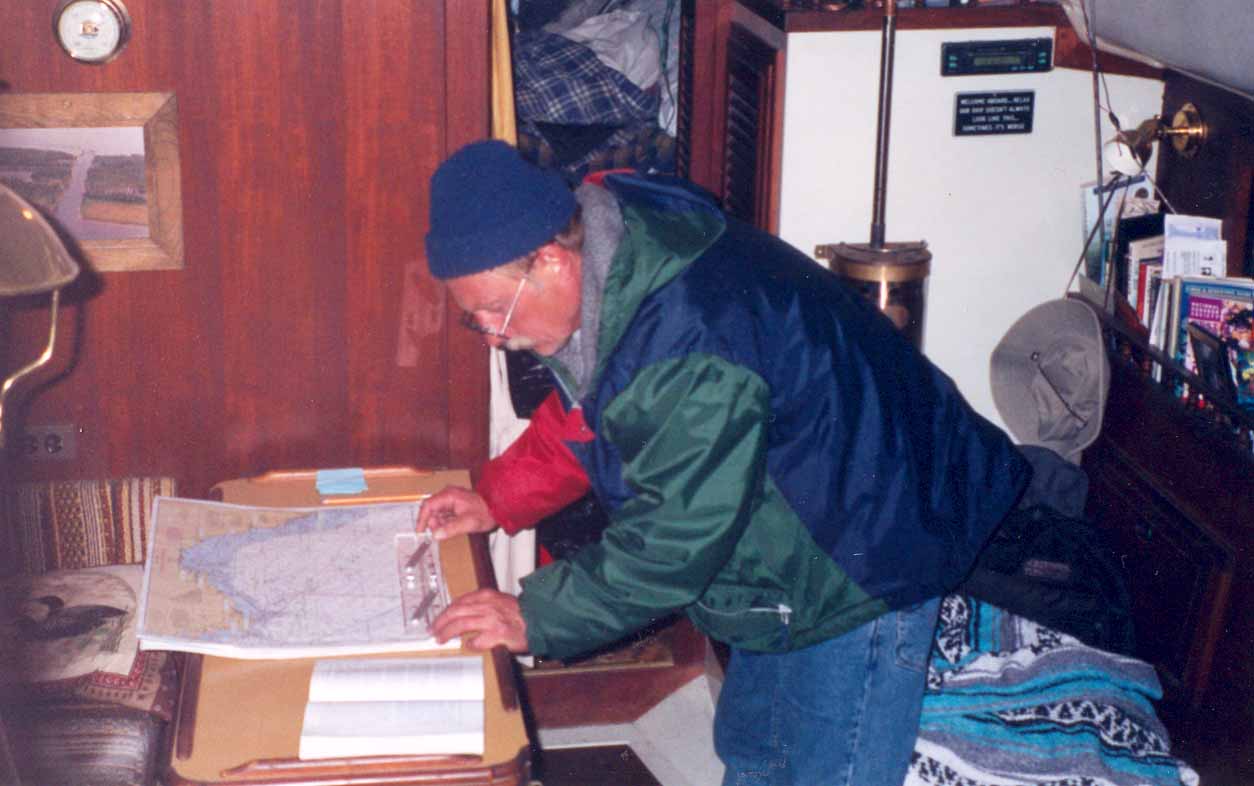 |
| Captain Scott refers to the paper charts to ensure we’re on track; during overnight passages we spend off-watch sack time on the salon settees. |
On another Gulf of Mexico all-nighter,
the sailboat Rikava, a Pearson 38 from
Ft. Walton Beach, Florida, made the
26-hour passage from Apalachicola to
Tarpon Springs with Faith Afloat and
Chip Ahoy. With the fastest boat of the
trio and the most experience sailing the
Gulf, Rikava’s husband/wife crew Rick
and Kathy saved us major headaches by
alerting us to the thousands of crab
pots liberally peppering the approach to
our destination. “They’re hard to see in
these waves, so keep a sharp lookout,”
Kathy advised on the radio.
Alone or in company, having the
equipment and a plan for managing a
longer passage involving night travel
are key to reaching your destination
safely. Radar is a must, as far as we’re
concerned. A spotlight and a floodlight
are also essential for dead reckoning.
We have both aboard, hand-held types
with long cords to ensure maximum reach.
They’re stored in a handy spot and
regularly tested. We make sure all
flashlights are in good working order as
well, and stash them in key positions
around the cabin, engine room and
cockpit.
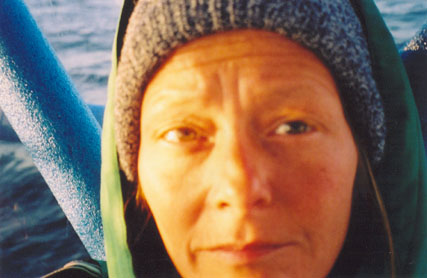 |
| Face of an All-nighter: I’m not a pretty sight after the 3-7 a.m. watch, but the sunrise off Pictured Rocks National Lakeshore in Lake Superior sure is beautiful. |
An autopilot and laptop chart plotter
are nice, not needed. That said, Chip
Ahoy’s set-up linking laptop charts and
plotter with GPS and autopilot is an
efficient and enjoyable way to travel
long distances. Especially for a crew of
two, the autopilot is an important team
member, relieving captain and first mate
from the tedium and fatigue of extended
time at the tiller or wheel.
Adequate sleep is crucial to successful
passagemaking. For safety’s sake it is
necessary to slumber in shifts. Don’t
con yourself into taking a chance on
this. That’s how those collision horror
stories happen. Listening to music,
reading (visually scanning the area and
checking the radar every few pages) and
cockpit calisthenics are just a few ways
to stay awake and aware. When all else
fails, we pull out the wind-up alarm
clock and set it to go off every 10
minutes.
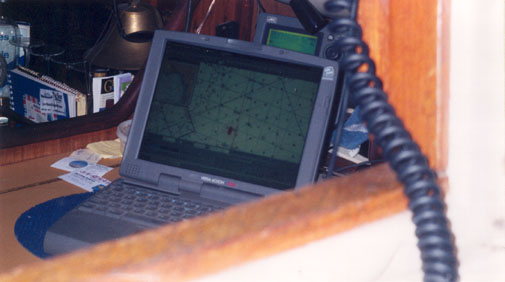 |
| Radar and laptop chart plotter interfaced with GPS and autopilot help guide Chip Ahoy down the Big Bend of Florida in the Gulf of Mexico. |
In our first summers cruising on Lake
Superior, my husband wasn’t comfortable
sleeping while the inexperienced sailor
(Yours Truly) was on watch. As I
increased my skill level and we talked
to other couples about their watch
strategies, he was able to catnap. Now
Scott can relax enough to catch a few
hours of quality sleep at a stretch. And
I actually sleep better when it’s my
turn, knowing he’s reasonably rested.
Rather than a 24-hour watch schedule, we
have a night schedule of two-three hours
on, two-three hours off, or more if the
captain decides to let me sleep.
Beginners may opt for one-hour watches.
Just remember that in bad weather nobody
sleeps!
Cyndi Perkins is a freelance writer
and full-time cruiser traveling with her
husband, Scott, aboard their 32-foot
DownEast sailboat Chip Ahoy. The couple
completed America’s Great Circle Loop –
a nine-month, 6,000-mile journey - on
June 4, 2004. Since returning to their
Lake Superior homeport in Houghton,
Michigan, they have been visiting and
revisiting favorite destinations on the
lake. Cyndi will be sharing other top
northern and Midwest destinations with
readers in her regular “Cruiser’s
notebook” feature.